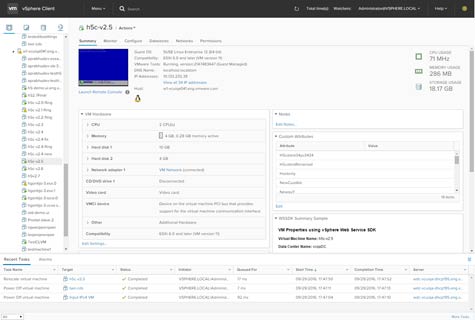At the VMworld Europe 2016 conference today, VMware outlined what amounts to a dual strategy that employs two core platforms to expand its appeal to developers and IT operations teams alike.
New features in VMware vSphere 6.5 include a version of VMware vCenter Server that enables the IT management software VMware employs to manage its environment to be deployed as a software appliance on the VMware hypervisor. Also on tap is new HTML5-based client software to provide a modern user interface through which VMware environments can be managed.
VMware is also adding a secure boot facility as well as support for encryption to secure virtual machines at rest and in motion.
Finally, version 6.5 of VMware vSphere includes an embedded version of VMware vSphere Integrated Containers (VIC) to make it possible to deploy Docker applications on top of VMware hypervisors as well as support for a new REST application programming interface (API).
Mike Adams, senior director of product marketing for VMware, says VMware is now making a concerted effort to extend the appeal of its most widely deployed platform to developers that want to be able to programmatically invoke VMware vSphere running on premise and in the cloud.
“Developers are starting to exercise more influence over the IT operations guys,” says Adams. “We want VMware vSphere to be seen as a universal app platform.”
As part of that effort, Adams says VMware plans to soon make it possible to deploy VMware vSphere anywhere inside or out of the cloud.
At the same time, however, VMware is recognizing that many of the developers driving the shift to containers prefer to use lighter-weight Linux hosts such as the VMware Photon Platform that now supports the Kubernetes container orchestration engine. VMware is also making a commitment to bring its NSX network virtualizations and VMware Virtual SAN (VSAN) software to the VMware Photon Platform. VSAN, as of the release of VMware vSphere 6.5, can already be used to provide persistent storage to container applications that invoke VIC.
In effect, VMware now has two core platforms in the form of VMware vSphere and VMware Photon Platform aimed at what is rapidly becoming a bifurcated IT market.
VMware also unveiled today an update to VMware vRealize Automation (VRA) that makes it possible to automate both virtual machines as well as any kind of Docker container host. The goal is to provide IT operations teams with a single framework to manage applications running on virtual machines and natively on containers. Other new offerings include updates to VRA components that make it simpler to customize reports.
Finally, VMware added a beta version of a disaster recovery offering based on the VMware vCloud Air public cloud that adds support for integrated software-defined wide area network (WAN) optimization.
VMware is clearly making a concerted effort to remain relevant to IT operations teams while adding programmatic capabilities such as support for REST APIs and a Linux container host that developers now routinely expect to be able to invoke. The degree to which VMware can increase its appeal to developers in the face of stiff competition naturally remains to be seen. But the one thing that is clear is that VMware is now pouring a lot of resources into accomplishing that goal.




